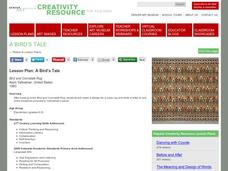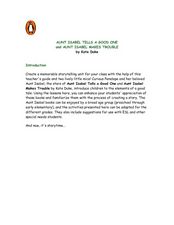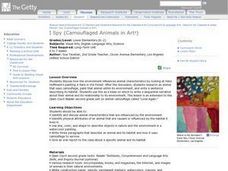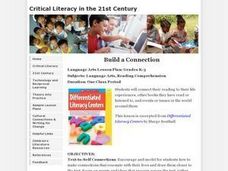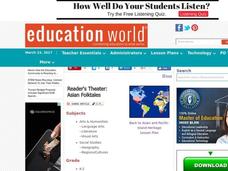Curated OER
Looking and Learning in the Art Museum
Have you just visited an art museum? Or can you create a gallery in your classroom to visit? Pupils create an original drawing that reinforces what was learned in a visit to the art museum. They will view original art work and verbally...
Curated OER
Guided Reading: Three Little Pigs (Plus Wolf: Javalinas)
Guide your class through reading various versions of The Three Little Pigs. Talk about the traditional story line and then discuss a different point of view: Maybe the wolf was just an innocent bystander! This lesson plan, which has...
Curated OER
Myths, Folktales, & Fairy Tales for Grades K-3
Have your class explore the art of storytelling through this lesson plan on fairy tales and folktales. Learners interact with a variety of fairy tales and folktales. They practice telling stories out loud as well as writing their own....
Curated OER
Lesson Plan: A Bird's Tale
Who wouldn't love to get a letter from a blue bird? Elementary art enthusiasts analyze the social and historical context of Ason Yellowhair's Navajo piece, Bird and Cornstalk Rug. They examine the construction and images on the rug...
Curated OER
What Is the True Story of the Three Little Pigs?
Cozy up and listen to a recording of The True Story of the Three Little Pigs and The Three Little Javelinas. Then, lead your class in a compare and contrast of the two stories by creating a Venn diagram.
Curated OER
Palace Adventure
Young language arts learners write and illustrate a short fantasy story based on the book Corduroy. First, learners need to develop a character. Then, through their writing and illustrations, they take their characters on adventures...
Curated OER
Retelling
Explore language arts by completing a story worksheet in class. Readers will identify the importance of plot, setting, and character while they write their own short story. They also retell their story to a classmate and participate in a...
Curated OER
Aunt Isabel Tells a Good One...
Explore language arts by reading two similar stories in order to compare and contrast them in class. Young readers read two Aunt Isabel books, by Kate Duke, and discuss the main characters, plot, and setting. They complete a graphic...
Curated OER
What Does Art Sound Like?
Help your charges investigate visual art by identifying sounds that are associated with the images. They view art galleries online and discuss which sounds would be present if the image was a real life situation. Additionally, they...
Curated OER
Editing Marks, Part 1
Dander from the show Twisted Whiskers and characters from My Little Pony are featured in this three part lesson that explores using story pyramids to scaffold ideas, adding sensory details to enrich writing, and editing using common...
Curated OER
Teaching Language Arts with Sayings and Phrases
Students complete a unit to learn sayings and phrases that help them understand language art concepts. In this sayings and phrases lesson, students complete 11 lessons that use common sayings and phrases to teach language art concepts...
Curated OER
Three-Meal Weather: Food inspired adjectives from "Cloudy with a Chance of Meatballs"
Students complete a list of food adjectives based on the book Cloudy With A Chance of Meatballs. In this adjectives lesson plan, students also compose a 3 part piece of writing based on an entire day of raining food.
Curated OER
Black History Lesson Plan: Gwendolyn Brooks
Learn more about the work of Gwendolyn Brooks with a language arts lesson. Young learners read an informational passage about the acclaimed poet before attempting a shape poem of their own.
Curated OER
Comparing and Contrasting Heroes
Here is a language arts lesson that can be used with virtually any grade level. The only thing that changes is the reading level of the books. Learners compare and contrast different heroes and the characteristics they hold. They use a...
Curated OER
The Art and Science of Impressionist Color
Discover Impressionist painting as students investigate the 19th century combinations of colors characteristically used. Students experiment with their own paintings, utilizing primary and secondary colors.
Curated OER
What is a Haiku? How Do You Write a Haiku?
Haiku poetry is explored in this language arts instructional activity. Yong readers identify the characteristics of haiku and read several examples. Students make connections between their study of Japan and the poetic form of haiku, and...
Curated OER
Through the Eyes of the Big Bad Wolf
Imagine how the wolf would tell the tale of Little Red Riding Hood or The Three Little Pigs. Young writers re-imagine classic tales by adopting the point of view of another character in the story. After reading models like The True Story...
Curated OER
I Spy (Camouflaged Animals in Art!)
Make connections about animal characteristics and the animal's environment. In this animal characteristics lesson, young scholars use a piece of art as a springboard for a discussion about animals and camouflage. Students choose an...
Curated OER
Build a Connection
Learners discuss their personal connections with stories they've read in the past and identify techniques to connect with more stories. They create illustrations, construct task cards, and complete sentence stems based on books they read...
Curated OER
Language Arts: Ready, Set, Write
Learn that stories have three parts by paralleling the introduction, the body and the conclusion to the life of an athlete competing in the Winter Games.
Curated OER
Teach Text Features & Read Nonfiction
Elementary schoolers examine the components of reading nonfiction. They use think-alouds to help them complete reading the selected sections. They also identify text features as they read.
Curated OER
Animated Alphabet
Learners explore English by completing an interactive language history activity. In this word recognition lesson, students discuss word formations and the phonetic relationship between letters. Learners identify the origin of individual...
Curated OER
Different Strokes For Different Folktales
Young readers use graphic organizers, such as Venn diagrams and story maps, to analyze a variety of folktales and the elements of a story. They use writing, sequencing activities, and creative art to identify the morals learned from a...
Curated OER
Reader's Theater: Presenting Asian Folktales
Students, working in groups, rewrite Asian folktales as Reader's Theater scripts. Depending on grade level, they visit Websites and copy assigned stories. Students then perform their versions for classmates.





